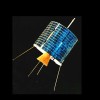


SatCom Scientist
Writing occasionally about space missions, astronomy, planetary science, satellites and science in general.
He/Him
#science #space #technology #astronomy #satellites #Democracy
This profile is from a federated server and may be incomplete. Browse more on the original instance.